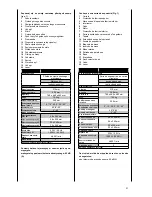
43
Troubleshooting
Fault
Possible cause
Remedy
Motor does not work
Motor, cable or plug defective, fuses burnt
Arrange for inspection of the machine by a
specialist. Never repair the motor yourself.
Danger! Check fuses and replace as necessary
The motor starts up
slowly and does not
reach operating speed.
Voltage too low, coils damaged, capacitor
burnt
Contact the utility provider to check the
voltage. Arrange for inspection of the motor
by a specialist. Arrange for replacement of the
capacitor by a specialist
Motor makes excessive
noise
Coils damaged, motor defective
Arrange for inspection of the motor by a
specialist
The motor does not
reach its full power.
Circuits in the network are overloaded
(lamps, other motors, etc.)
Do not use any other equipment or motors on
the same circuit
Motor overheats easily. Overloading of the motor, insufficient cooling
of the motor
Avoid overloading the motor while cutting,
remove dust from the motor in order to ensure
optimal cooling of the motor
Reduced cutting power
when sawing
Saw blade too small (ground too much)
Readjust end stop of the saw unit
Saw cut is rough or
wavy
Saw blade dull, tooth shape not appropriate
for the material thickness
Resharpen saw blade and/or use suitable saw
blade
Workpiece pulls away
and/or splinters
Excessive cutting pressure and/or saw blade
not suitable for use
Insert suitable saw blade
Dépannage
Panne
Cause possible
Remède
Le moteur ne
fonctionne pas
Moteur, câble ou connecteur défectueux,
fusibles grillés
Faire vérifier la machine par un spécialiste. Ne
jamais réparer le moteur soi-même. Danger !
Contrôler les fusibles, les remplacer au besoin
Le moteur fonctionne
lentement et n'atteint
pas la vitesse de
fonctionnement.
Tension trop faible, bobinages endommagés,
condensateur grillé
Faire contrôler la tension par votre prestataire.
Faire contrôler le moteur par un spécialiste.
Faire remplacer le condensateur par un
spécialiste.
Le moteur est trop
bruyant
Bobinages endommagés, moteur défectueux Faire contrôler le moteur par un spécialiste.
Le moteur ne
fonctionne pas à plein
régime.
Circuit de l'installation électrique surchargé
(lampes, autres moteurs, etc.)
N'utilisez aucun autre appareil ou moteur sur
le même circuit électrique.
Le moteur surchauffe
facilement.
Surcharge du moteur, refroidissement
insuffisant du moteur
Empêcher la surcharge du moteur lors de la
coupe, éliminer la poussière du moteur pour
garantir un refroidissement optimal du moteur.
Diminution de la
puissance de coupe
lors du sciage
Lame de scie trop petite (affûtée trop
souvent)
Régler à nouveau la butée de hauteur de
coupe du module de sciage.
La découpe de la
scie est rugueuse ou
gondolée
Lame de scie émoussée, forme de dents
inadaptée à l'épaisseur du matériau
Réaffûter la lame de scie ou utiliser une lame
adaptée
Pièce cassée ou
fendillée
Pression de coupe trop élevée ou lame de
scie inadaptée
Utiliser une lame de scie adaptée
















































